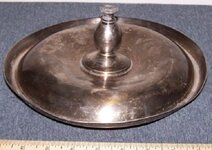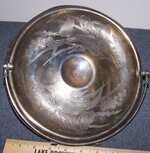frankendime
Hero Member
Was in Goodwill a week ago or so and they have bid cases in front of the store they put good stuff in and you bid on the items on bid sheets. Saw this piece with some other obviously silver plate pieces. Asked for the bid sheet and was told they did not have it made up yet. I'll be back says I. Went back in 3 days later and still no bid sheet. Store manager came out and said " Ok I'll go make one" turned and asked "Do you just want the one piece? I says "Yes. I like the butterfly pattern and may have a stand I can attach to it somehow" She looks at it and says "How does $1.49 sound" I thought that was ok and told her so.
As you can see the base is broken but what attracted me was the great etching, very highly detailed told me quality. No marks anywhere on it. I'm guessing it would have been on the base, which is missing. Heavy, weighing 1.4 pounds. Kinda soft and bent without to much difficulty. Easily scratched or carved with my pocketknife, and looks silver as deep as I scratch. Reaction to acid is dark gray or black. Could it be
HH ALL!
As you can see the base is broken but what attracted me was the great etching, very highly detailed told me quality. No marks anywhere on it. I'm guessing it would have been on the base, which is missing. Heavy, weighing 1.4 pounds. Kinda soft and bent without to much difficulty. Easily scratched or carved with my pocketknife, and looks silver as deep as I scratch. Reaction to acid is dark gray or black. Could it be

HH ALL!






